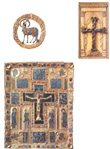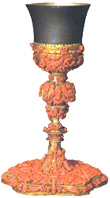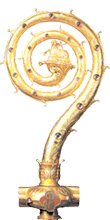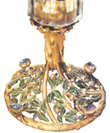|
|||||||||||||||||||||
|
||||||
| The venerable workshop of the Duomo, known as the "Veneranda Fabbrica del Duomo", with its six centuries of history behind it, continues to fascinate us all. In these pages we take a look at several works of art that are representative of a diversified universe that differ widely in type as well as in artistic and historical content. In the words of Monsignor Angelo Majo, the duomo's senior cleric: "Milan's Duomo is not only a splendid monument of art and faith. But it is also a coffer that contains art of incomparable value. "Ivories, sacred vases in gold and silver, vestments, standars, tapestries - most of them donated by ecclesiasts, many of them noblemen and princes - are offered, to the admiration of visitors in small rooms. Even more treasures are to be found in the main vestry, but unfortunately they are unaccessible to the general public, " Majo says. Diamonds, ornamentals stones and precious gems enrich the sacred furnishings stored in the Treasury. For the first time in 1977, these works were described by experts in an inventory. Recently, Cisgmen (the Centre for Informantion and Gemmological services of the Chamber of Commerce of Milan) analyzed the treasures from a gemmological point of víew using non-destructive methods. With instruments that range from simple lenses of various magnifications, to refractorneters to determine the refractive index, to ultraviolet lamps to analyse the presence of fluorescent compounds, to calibrators, to various precision scales, to polarised light stereomicroscopes to probe the interior of the gem, Cisgem analysts have determined the nature of the various Treasures. Among the most valuable objects on display in the Treasury, there is the so-called "Diptynch of the fíve parts" which is rnade of two shells, each one formed of five thin plates crafted in bas-relief. In the Theasury is also kept the silver capsule of Saint Nazarus (from IVth century); the gospel book of Ariberto (XIth century); two silver statuettes encrusted with precious stones of Saint Ambrogio and Saint Charles (XVIIth century), a gift of Mílanese goldsmiths that since the restoration have been placed next to the ciborium in the Duomo's renovated presbytery. Of particular interest is the ecclesiastical staff, made in 1881 by Mellerio, a local company, and donated to Archbishop Luigi Nazari da Calabiana to commemorate his sacerdotal jubilee. At its extremity, the staff has a double curl which surrounds the figure of a gold plated silver lamb with a cross. 0n each side are mounted 17 amethysts. The round Cabochon - cut stones are disposed in decreasing order of size towards the centre of the spiral. On the pummel another four amethysts are mounted next to four enamel medallions which, represent Saint Peter, Saint Ambrose, Saint Charles and Saint Louis. The Airoldi chalice is the most beautiful. It was made by Sicilian artists in the XVIIth century and given by Carlo Francesco Airoldi, bishop of Edessa and apostolical Nuncio of the republic of Venice. The stem of the chalice is of gilded copper, while the cup itself is of gilded silver. It is finely crafted with a decoration in dark-red and orange coral, with leaves, angels and cherubs' heads. In 1985, the Duomo's Treasury received the Chiaravalle cross, a complex work of art crafted to the front and from behind with chisled strips of gold and silver, with a filigree with hundreds of encrusted gems. According to tradition, the cross was donated in 822 by Ludovic the Pious, during the reign of Carolus Magnus. Over the course of the centuries it underwent several restorations. In 1799, the cross was bought by the Chapter of San Celso for keeping in the shrine. Cisgem has analysed various stònes, among which several types of colored glass, 80 garnets, 80 sapphire like natural corunda, two natural rubies, green quartzes, and red jasper. Lastly, the finely made Ambrosian monstrance of the Castiglioni family once used for the Corpus Domini procession. The most striking part of this work is the case and in the sphere that supports the golden cross, The two are made of rock crystal. Other salient features of the cross include numerous natural gems defined by Cisgem like sapphires, natural rubles and natural yellow pearls and enamelled decorations in the shape of leaves. Cisgem Cciaa has pubblished a descriptive booklet with the results of the analyses and the historical tips about some of the most beatiful works in the Duomo's Treasury. |
||||||
|
||||||
|
||||||



